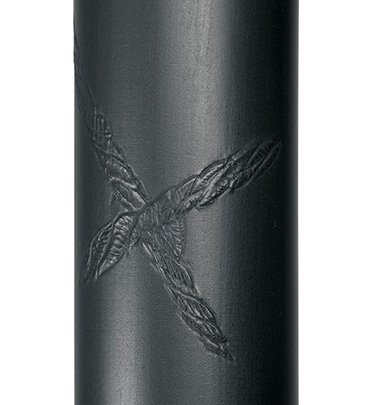Michael Puryear: Documentation in Design and Materials
From American Craft Inquiry: Volume 2, Issue 2
Michael Puryear describes himself as a furniture maker, but his work shows that he is far more than that. As the recent acquisition of his Dan Chair (2010) by the Smithsonian Institution attests, Puryear is also a kind of historian, one who uses the tools of material culture to plumb our nation’s history and provide truth and insight into the story of how African Americans came to be here. The artist, who characterizes himself as an artisan, uses functional design to subtly tell stories of the complex and fraught relationships that African Americans have with the country where they live. With his attentive selection of historically resonant materials, allusions to particular cultural styles, and his considered, detailed craftsmanship, Puryear creates objects that suggest political and social analysis can be produced with block plane, dovetail saw, mortise chisel, and joiner’s mallet, and that an archive can consist of more than a collection of books and personal documents.
It is fitting that the Smithsonian chose to acquire Puryear’s Dan Chair and display it at the National Museum of African American History and Culture. This museum aspires to comprehensively tell the story of how people who have come to call themselves African American or black have developed within a nation that has almost unremittingly sought to define, bracket, and curtail their opportunities. Nevertheless, as the collection of arts, sports, music, cultural, and design memorabilia and objects show, African Americans have found, often in circumstances of deep despair, how to “make a way out of no way.” This phrase shows up again and again throughout the museum collection, as individual achievements are documented and collective triumphs celebrated. Beyond its affirmation of African Americans’ resilience, the museum’s collection points to the special nature of their relation to this country: They are within it, but not primarily of it.
Any story truthfully told of black people in the United States must acknowledge that they have cultural and genealogical roots in the African continent, yet since the very dawn of the American Revolution — the great experiment in democracy — they have been sewn into the fabric of this country. Crispus Attucks, an American stevedore of African and Native American descent, is widely recognized as the first man to be killed in the Boston Massacre of 1770, the opening volley in the War for Independence.
To be black in the US is to exist in contradiction: loved and loathed, incised in history yet frequently excised from it, held up as a symbol of profound achievement or ugly failure, dominant in our athletic contests but decried for changing the ways these games have been played, inventors of unique forms of art that are distinctly American (jazz, tap, blues, rap) yet widely regarded as intellectually deficient. Puryear brings to the surface these underlying tensions and oppositions by designing his Dan Chair to link an African past to a present that is still shadowed by chattel slavery.
Puryear named his piece the Dan Chair because it is like those used by the Dan people (also called Gio or Yakuba) of the west-central regions of Côte d’Ivoire (Ivory Coast) and nearby areas within Liberia. This geographical area is also known as the Gold Coast or the Slave Coast, referring to its history as a major source of African people who were captured and sent to Europe and North America during the Atlantic slave trade from the early 16th century to the late 19th century. This is where Puryear’s archival research begins: in these investigations of the origins of people from whom many African American families descend. He had seen this kind of low-set chair in books over the years and was intrigued. But before he would venture to make a version of it, he needed to source the proper materials.
William E. Jewell, the founder of Historical Woods of America, was an avid researcher of wood with historical significance. As Puryear told me, Jewell had offered these woods to various furniture makers in order for them to make work that would, in essence, make palpably present that which had been consigned to a conflicted antebellum past. Puryear specifically requested pecan wood from Mount Vernon, where George Washington had a plantation, and poplar from Monticello, where Thomas Jefferson also had a property maintained by the labor of enslaved people. Jewell had these, so Puryear was able to begin constructing the chair with them. For Puryear, it was crucial to use the woods as a kind of archive on which to build an argument that Washington, the first president of the United States, and Jefferson, a primary author of the Declaration of Independence and the third president of the United States, were not only crafters of a new foray into a democratic form of government, but were also slaveholders who reaped the benefits of the labors of those who had no say in how they could live.
Thus a man who was himself a descendant of slaves turned himself into a chronicler of African American history, and a maker of objects that provide for the stable domestic life his ancestors never had. Puryear combined the pecan and poplar woods into a form that consists of a flat rectangular base set between two thicker, framing slats with rounded edges. In the chair, this base is held aloft by four chair legs that resemble elongated bottles with tapered necks and rims near their base. On top of the chair is a curved top bar with angled ends that provides support for the sitter’s back, connected to the seat with a pair of long tapered bars that connect to the seat floor. It is an elegant work, finished with a burnished graphite that creates a delicate metallic silver sheen. Puryear tells me that this finish makes it a proper museum showpiece, because if it were touched, it would react to the oils in a person’s hands and thus lose its magic gloss from casual handling.
The two front legs have raised markings in the wood that allude to the marks created by a lash on human skin. The process for creating these raised patterns is laborious. First, the maker has to make indentations in the wood, then place the pieces on a lathe and sand them down until they almost disappear. Then the areas are steamed to make the wood molecules expand with the moisture. The result is markings that won’t disappear. They are testament to what Puryear terms “the scars of bondage.” They are metaphor, design element, and historical marker, an extension of that critical consciousness that Puryear brings to bear on the pieces he makes.
Puryear says he is “basically expressing my pride in being the descendant of slaves.” Typically, one expects those who have this ancestry (as I do, being born in Jamaica – close to, but not exactly mirroring Puryear’s ancestry) to feel shame at being identified as the descendant of slaves. But Puryear is a discerning student of history. He says, “I feel that slavery has contributed so much to this country, and it’s so underacknowledged that I ... am really proud of what we have done as a people, and want to acknowledge that.”
And this is where the artisan raises his practice to a place where he helps us collectively make sense of our common US history. Through the chair, we begin to understand how the story of African-Americans is indeed both degraded and triumphant. It is only through the slave labor extorted from conscripted migrants that the infrastructure and industries of the United States gained a foothold and thrived. The position of African American workers and slaves is not incidental to the larger story of the formation of this country. It is essential, crucial, deeply embedded. This is very likely why Smithsonian curator Michelle Wilkinson, upon seeing Puryear’s chair at the Smithsonian Craft Show, knew that it belonged in the nation’s collection – as part of the story of how it had come to be.
Puryear began his own educational development a long time ago, in a family, he tells me, where learning about the history of the United States was “organic.” He often visited the Smithsonian as a young boy, taken there by his parents, who wanted to give him the sense that this heritage rightly belonged to him. He found that this story not only belongs to him, but also that he can add his voice to its telling. He does his telling with the Dan Chair in an idiom that is coastal African, ancestral and unique, buffed and shaped by the experience of building up a fledgling nation on backs that were whipped and savaged, interpreted by American hands. Michael Puryear gives us our history back through his furniture pieces, showing that there is conflict, denial, and pain in our past, and that in our moments of clarity and repose, we should sit with that knowledge and learn how to live with it.
Read more from the fourth issue purchase issue





